#kiersau abbey
Explore tagged Tumblr posts
Text

love is the only reason to do anything in this life.
329 notes
·
View notes
Note
Out of all the residents of Kiersau do you have a favourite? Do you have a favourite pentiment character overall?
Illuminata was my favorite abbey character to write. She probably got more of my writing time than anyone else at Kiersau and she was an interesting character to develop. I think I originally conceived her as being even more strict and uptight, but as I continued iterating on her, I found sympathy and leniency in her.
On one of my last writing passes, I added a branch in Act I where you can ask her if she prefers the strict Father Gernot to the lenient Father Mathias. She says it's her duty to obey so it doesn't matter, but, "... every child would prefer that their parents err toward love. To err toward love is to stumble at the feet of God."
She's strict and judgmental but in the end she bends toward forgiveness and grace.

533 notes
·
View notes
Text
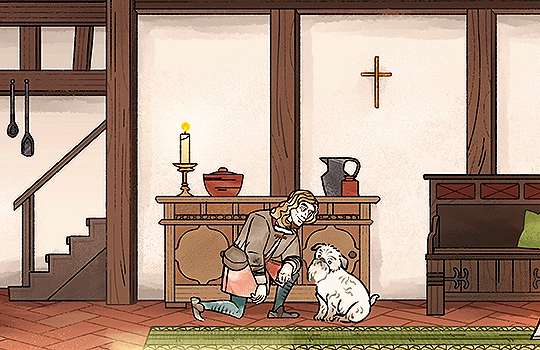
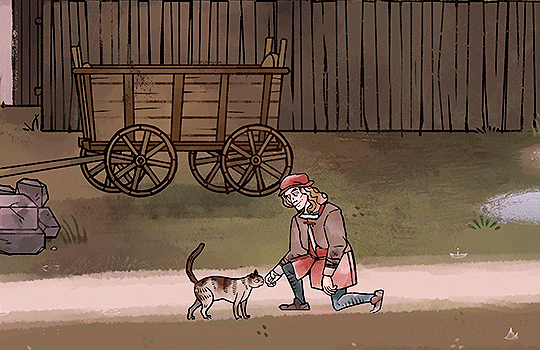
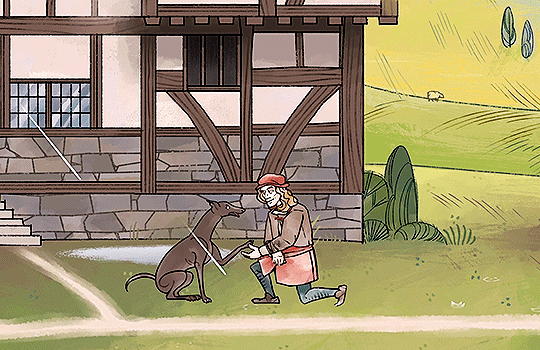
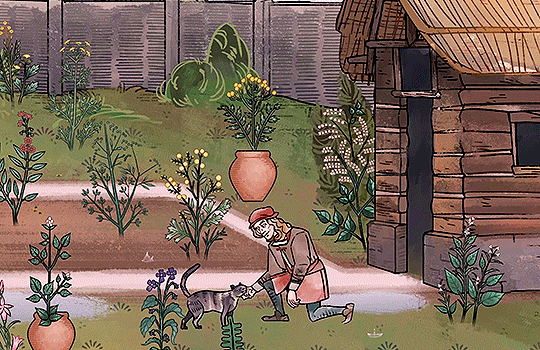
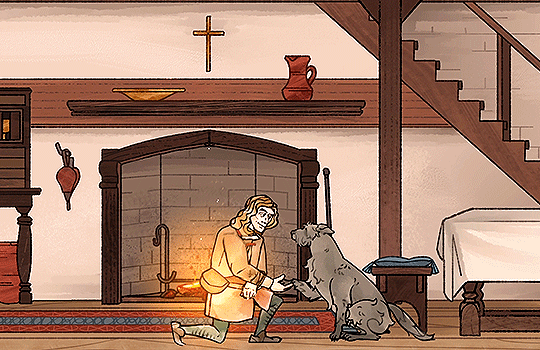
PENTIMENT (2022) Andreas Maler petting animals in Tassing and Kiersau Abbey
#pentiment#andreas maler#videogameedit#gamingedit#gamingnetwork#dailygaming#gamingcreatures#obsidian entertainment#hate how this turned out but here goes#pentimentedit#mine: gifs
430 notes
·
View notes
Text
Hello friends and please behold my own personal masterpiece, an as-comprehensive-as-I-could-make-it "Which character are you?" quiz for Pentiment with thirty-six different possible results.
Please be warned that there are spoilers for the game within, in both the structure of the quiz and some of the descriptions in the results! That said, I have poured a lot into this and I am so curious to see what results people get, so I would love if folks gave it a look.
#started this uhhh. four months ago#a significant amount of research and having my friends playtest it later though i think it is finally ready to be released#thanks to scribe and also everyone in my little server for letting me bounce ideas off you all. i have really enjoyed making this quiz#pentiment tag
626 notes
·
View notes
Text
Round 2, Match 1
The Reverend Daughter Harrowhark Nonagesimus (The Locked Tomb) vs Sister Margarete of Krimml (Pentiment)


Harrow is a nun of the Ninth House. She's been described as a space goth necromancer fantasy sci-fi bone nun.
Sister Margarete is a Benedictine nun at Kiersau Abbey, and works as an assistant herbalist.
The Reverend Daughter Harrowhark Nonagesimus
She’s great. She has so many fucking problems. She’s been running the goth space convent since she was 10. She’s puppeting her dead parents around. She doesn’t like tastes. She is extremely passionate about bones. She’s locked in a twisted bond of love and violence and devotion and sacrifice with her childhood best enemy. She lobotomized herself to preserve the best enemy’s soul. She’s been in love with the corpse of the Devil all her life. She goes around in bone jewelry and skull face paint. She’s a sad wet cat who was born in a cardboard box all alone, etc. She chopped another woman’s arm off and regrew a skeleton arm, in a sexual way. She has awkward little fireside chats with God where he makes millennia-old meme references at her and she does not drink the proffered tea. She saw God make a your mom joke and it “destroyed some cavern of her reverence”. She’s even gay. She’s everything.
Sister Margarete of Krimml
No propaganda submitted.
Poll Runner's Note: While Sister Margarete lost her eyesight after a failed cataract surgery, she's quite perceptive. She's able to recognise Andreas purely from the smell of paint and linseed oil.
#best nun tournament#Round 2#Poll#Poll Tournament#harrow nonagesimus#harrow the ninth#The Locked Tomb#tlt#Margarete Pentiment#Margarete of Krimml#Pentiment
36 notes
·
View notes
Text










so i finished playing pentiment (2022, dev. obsidian entertainment)!
what a game! i cannot sing this one enough praise, but i'll do my best. to contextualize, this one has been on my radar since before release. there are a few people in the gaming industry whose work resonates deeply with me. be it due to the way they approach games and even the subjects they tackle. one such person is josh sawyer, who also was in charge of my favorite rpg series, pillars of eternity. and pentiment is his passion project after working on those games. i knew i was going to love this one, and seeing my wife play it and love it was what i needed to dive in headfirst at all. and boy, did i love this one and did it touch me in my soul
the game is set in early modern era, 16th century upper bavaria, in the fictional town of tassing. you control andreas maler, who through being an artist hired to work at the local kiersau abbey's scriptorium, is uniquely positioned to interact with the secular world of peasants and townsfolk in addition to the monks and nuns at the double monastery. this is an rpg that puts its emphasis on the narrative. this is a story that deals with the life and trials of this small town and abbey, especially when normalcy is disrupted by a murder. andreas is cast then as the investigator.
overall, pentiment takes full advantage of the gaming medium in such a way that this story could not be better told with other mechanics nor with other visuals. to illustrate: there is no voiceover, so dialogue is presented through fonts that communicate status (there are fonts for peasants, nobles, scribes, printers, and monastic people), diction (you will find that people who are less educated will have more typos in their dialogue, which are promptly corrected as if you are witnessing a writer lay out the story for you), and andreas' perspective on each person (people may change font as andreas learns more about them). there is a glossary that is filled with marginalia in the style that used to be seen in illuminated manuscripts.
the story spans a long period of life in tassing and kiersau, and you witness that passage of time at a macro level, together with changes and loss and the stories that people construct to give meaning to time's effects. at a moment to moment level, time will force you to make decisions and to see a slice of life in this period of history. you will work during work hours, at meal hours you may find one of the households willing to welcome you at their table and break bread with them. the writing and the people are deeply human. and like humans, each character is beholden to chains of events that test them and reveal who they are. all in all, the writing was excellent and if you enjoyed the themes explored in the first pillars of eternity, i'm sure you will enjoy pentiment as well.
13 notes
·
View notes
Text


Been playing Pentiment this past weekend (I just got to Act III today) and I fell in love immediately with the characters and story, so I decided to make an oc ^^ Her name is Dorothea, and she is one of the nuns at Kiersau Abbey
I like to imagine that her and Sister Zdena are very close, as Dorothea would ensure her that she can always talk to her about anything (she has a massive crush on her too but I’ll say more about that in future posts)
Also she doesn’t like Andreas (not that I have anything against him, I actually love him I just thought it’d be funny if she didn’t like him, and she also kind of has a reason for it? Still figuring it out lol)
Anyway. I hope the Pentiment fandom is still around 👀
8 notes
·
View notes
Text
Prelims round 1, poll 4






Propaganda
Scarlet Hollow Town Hall/Library, Scarlet Hollow:
-has a stupid creepy ass mural depicting the murder the town did to the local coal baron in the 1800's
-literally haunted
-dilf librarian
-dilf librarian's house is a part of the same building
-has a cat
-dogs are allowed
-makes you repent for your family's sins
-the town mayor is a dog and they host him in the library every month on "mayor jimmy day"
The Arcanaeum, The Elder Scrolls V: Skyrim:
Urag gro-Shub is BAE. And it’s a very pretty library.
The Archive (with the recipe book), Fullmetal Alchemist: Brotherhood:
None
The School Library, Clannad (visual novel):
you meet the sad girl with science autism in there
Kiersau Abbey Library, Pentiment:
You know how libraries these days are places for more than just books? This was one of these 500 years before it was cool. Here you can find old heretical texts, hot nun goss, secret passages, gay sex, delicious symbolism that represents the crumbling of an oppressive religious institution and increased education for the masses... what more could you ask for?
UPDATE: Minecraft Uncensored library has been disqualified for the reason of not being fictional.
Please don't vote for it. If it wins, the second place library will go through instead. Apologies for not catching it earlier.
#fictional libraries#tumblr tournament#archives#books & libraries#fictional archives#libraries#tumblr polls#poll#scarlet hollow#Oscar Gutierrez#black tabby games#minecraft#mc#pentiment
63 notes
·
View notes
Text


I’m sure someone else has beaten me to it, but here’s a translation of the ledger Andreas can find in the abbey library, with my translation notes – long post below the cut:
Mother Katharine, Prioress AD 1459[1]
Sister Hildegard, 16 years old Named Anna Gölderich, of Ravensburg. Proficient in Latin. Studious and obedient, with a soft, pious voice. 150 florins donated by her father. Additional 15 florins annually.
Mother Hildegard[2] AD March 1481
Sister Cecilia Daughter of the Welser family of Augsburg[3]. Named Adelheit. She is wise and learned in Latin and French. 200 florins given by the family before her arrival. Additional promise of 20 florins annually. AD August 1505
Sister Gertrude Named Metze[4] Huberyn, born in the Variscan Court[5]. Minimal proficiency in Latin. Kind and knowledgeable about herbal medicine. Most knowledge passed down by her father, an apothecary, who donated six florins to the monastery.
Sister[6] Matilda, 17 years old From Kempten[7], named Matilda. Moderately proficient in Latin. Calm, disciplined. Daughter of a Frisian merchant who donated ten florins and a large quantity of ultramarine pigment for the Scriptorium’s use. Mittenwald Ascetarium, May 1515 to September 1515[8]
Sister Illuminata Named Angelina, from the noble Capocci[9] family of Perugia, who were close to Abbot Rudolf[10]. Extremely learned in Latin as well as French and Germanic languages[11]. Restrained[12], sensible, and perceptive. The Capocci family donated 50 florins before her arrival, with an additional promise of 20 florins annually. 1507
Mother Cecilia, Prioress February AD 1510
Sister Sophia Born to the Hafner family in Birgitz. No knowledge of Latin but gentle and reverent. Parents are humble paupers. Three sacks of flour donated. AD 1512
Sister Lijsbet, 34 years old Born in Dutch Trecht[13], from the Hack Woutersen marriage[14]. Moderately proficient in Latin but proficient in Saxon. Hardworking and pious. Merchant parents. She has long been connected to Kiersau through her mother’s family, the Kaufmanns of Rothenburg ob der Tauer. They gave 12 florins, with an additional promise of two florins annually. AD 1514
Sister Margarete From the Auer family in Krimml. Mostly blind due to glaucoma. Can see colours. Moderately proficient in Latin. The daughter of wealthy peasants who each donated bags of wool and pastureland in Krimml. AD 1515
Sister Zdena The third daughter of the Ro��mberk family of Tábor[15]. Very learned and proficient in Latin. The Rožmberks paid 100 florins before her arrival, with an additional promise of 30 florins annually.
---
[1] In the original text, the year is written as MCCCCLVIIII. Typically this would be written as MCDLIX, in accordance with subtractive notation (i.e. how we normally write Roman numerals), but there are historical examples of additive notation sometimes being used, for some reason – sometimes both would be used interchangeably in the same document, or even the same number.
[2] This entry likely documents Hildegard’s promotion as opposed to there being two Hildegards in the abbey, as there’s no other information included and the same is done for Sister, later Mother Cecilia below.
[3] The Latin here is originally pretty clunky and obscure (“Welser daughter of the Augsburg Vindelici”); Andreas explicitly mentions Cecilia’s family as well (and telegraphs other important information for the player this way). The Welsers were a German merchant family that rose to prominence in the 16th century as financiers for the Habsburgs along with another family, the Fuggers. They accumulated their wealth mainly through trade and the German colonisation of the Americas, including enslaved labour, so. Yikes! The Vindelici were a Gallic people based in present-day Augsburg; I don’t actually know if the Welsers themselves were descended from them, but I’d assume so, given that the region is correct.
[4] Diminutive form of Mechthild.
[5] The contemporary name for Hof, believed at the time to be the seat of the Varisci/Narisci people.
[6] Sister Matilda is an oblate, as are Lijsbet and Magarete. Oblates aren’t professed monks or nuns, and so are technically part of the laity, but have associated themselves with a monastic community. They make formal promises – either annually or for life, depending on their affiliated monastery – to follow the Rule of the Order; as a result, they’re considered an extended part of the monastic community.
[7] I initially was stumped by this word and thought it referred to Matilda’s occupation in the abbey as cellarer, but then remembered Andreas reads she’s from Kempten, the old Latin name for which is, indeed, Cambodunum.
[8] Matilda’s age is either current in 1518, which would’ve meant she was 14 when Lorenz Rothvogel attacked her, or her record was retroactively updated to reflect her leave in 1515, making her 20+. Unfortunately, I think both are equally plausible, though being in her 20s would mean her relationship with Brother Wojslav, who imo appears to be older, has (slightly) less of an age gap.
[9] A quick search reveals the real-life Capocci were mostly associated with Viterbo, which is not Perugia lol.
[10] Another clunker originally.
[11] Theodiscus was the contemporary term referring to West Germanic languages; it comes from a Germanic adjective meaning ‘of the people.’ Since Latin was the language of science and religion, theodiscus was its opposite, i.e. the language spoken by the people.
[12] Retinēre very broadly means ‘to keep or hold back’ and so usually gets translated as either ‘to restrain’ or ‘to uphold.’ In describing a person, it can suggest any number of things: literally, physically restrained, or emotionally restrained, as in temperate or even repressed; someone who is steadfast and firm, or simply just is intelligent – as in, literally retains information well. Illuminata is all of these things, but I think ‘restrained’ suits her most compared to, say, tenacious.
[13] Utrecht. The city takes its name from the Roman fort Traiectum on the Rhine.
[14] Imma be real with you chief, other than Hack and Woutersen both being Dutch names, I have no fucking clue what this references – if anything – and I’ve found nothing that would help shed some light on it, either.
[15] The Rožmberk (Rosenberg) family was one of, if not the most powerful noble family in Bohemia from the 13th century until the early 17th century. Zdena is RICH rich, but her story is also pretty sad; it’s little wonder she’s Like That.
277 notes
·
View notes
Note
Tell us about different monastery burning motifs! Would be interesting to hear how each of them work narratively
hi! this was mostly explored when @st-vesta and I were yelling incoherently about it. I also don't have a very good grasp on The Name of the Rose as I've only watched the show. tbh I'm really only confident of my interpretation of PotE SO WITH THAT IN MIND
[SPOILERS FOR THE NAME OF THE ROSE, THE PILLARS OF THE EARTH AND PENTIMENT]
Right from the get-go their burnings are very different in when they come into the narrative. It comes very early on in Pillars of the Earth, with Kingsbridge Cathedral burning down right near the start. It's the force that drives the plot. Pentiment's Kiersau Abbey goes up in flames in the end of the second act as a culmination of the long-standing tensions over the course of five (?) years. The Name of the Rose ends its story with the burning of its mountain monastery.
How do they happen? Till the last second, Kingsbridge's fate was kinda just strung on a line of bad luck and split-second decisions. A forest boy named Jack tags along with a mason's family, becomes refugees of a burgeoning civil war, and ends up in Kingsbridge. He gets the idea to burn down the cathedral to give the kindly mason a job, and isn't even fully sure of his decision as he lights the vault boards on fire. He’s just a child.
And yet.
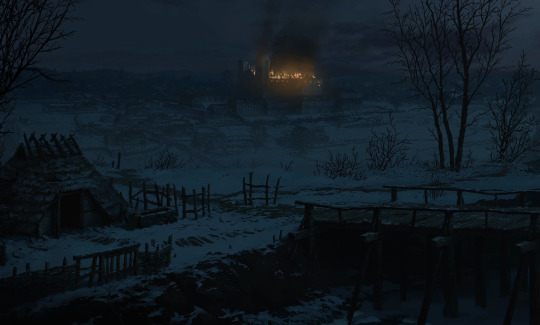
Fire is a catalyst. As much as it is a catastrophe, it also presents three groups of people all fucked by the hellscape of 12th century England with an opportunity to build something brighter. Aliena’s family and earldom taken by the Anarchy, Philip and his languishing priory, and Jack, coming from the fringes of society all working together to pull their futures out of the ashes of the cathedral… Kingsbridge and its town start thriving again.
(Fire is very much a motif in PotE. Someone as powerless as Jack using this volatile force of nature to bring down something as grand and sacred and built-to-last as a stone church! The Church controlling fire to produce a ‘miracle’ and restore faith in the institution! Fire as Hell, the only thing that has ever scared William Hamleigh! Fire as hope, Philip treading the aftermath and watching the sun rise with Tom!! I;m very ill)
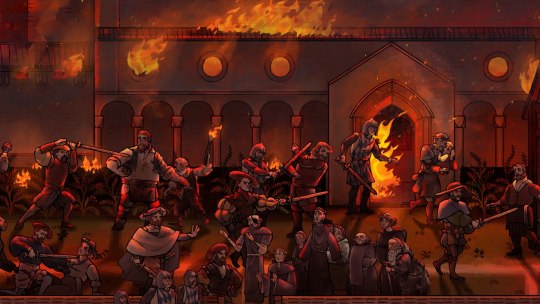
Kiersau and Tassing, on the other hand, have been fostering tensions that would eventually destroy the monastery. It is the powder keg’s inevitable explosion. Neither the village nor the abbey are willing to back down, so it culminates in a situation where one or the other caves in. Nobody has been having a Good Time for a Long Time. Especially not Claus. In his grief, he walks into the library and sets it on fire.
Fire is an answer. It is a terrible, terrible night. We are told that the Benedictines scattered to the wind. We don’t get to see the immediate aftermath, but does it matter? Magdalene explores the abbey and it is still the same derelict cathedral from years ago. She wasn’t there to witness it, but there its soot-stained carcass stands as a reminder of tragedy. Some saw it as a victory, certainly- the humble villagers triumphing over their Benedictine landowners. Things grew from it, though- Wojslav and Matilda find their new chapter of life here, Mathieu and Illuminata find new, loftier prospects outside of Tassing, and Andreas finds a way out of an unhappy life.
The mountain monastery in The Name of the Rose has a long-kept secret, and attempts to unearth it are met with death. It goes up in flames after a week of murders as a last-ditch effort by Jorge to destroy its library and bury its secret for good.
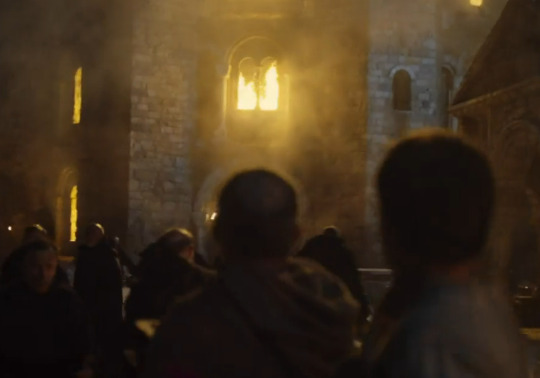
Fire is the end. No matter how grand and complex the library labyrinth was, it would have never held up against fire. William and Adso didn’t succeed. They couldn’t have saved the library and they couldn’t stop the deaths. Jorge did what he set out to do! The elusive Finis Africae is still shrouded in mystery and anyone who knew of the contents is dead! The monks disband and William comes out of it disillusioned.
TBH, all three of them make use of monastery burnings to destroy some hidden truth or secret. The history of Tassing? Records largely in flames, and even given to distortion, since we, the player, are able to interpret that segment! The truth about the White Ship? Gone with Prior James’ bones! And Finis Africae. Fire, if anything, can hide and rewrite.
TL;DR: fire do many thangs and pyromaniacs everywhere are right.
#pentiment#pillars of the earth#the pillars of the earth#the name of the rose#pentiment spoilers#pote spoilers#notr spoilers#birbwellspeaks#really my expertise is on PotE. ive only played through Pentiment once so i hope i can do this justice#though i also have lots of thoughts about how different Tassing and Kingsbridge are community-wise...#like. that response to the fire. and in general they are written v differently#ALSO SORRY FOR THAT SHITTY NOTR SCREENSHOT#i dont have the episode in good quality
74 notes
·
View notes
Text



But stand brave, life-liver, bleeding out your days in the river of time. Stand brave: time moves both ways,
in the nullifying, defeating, negating, repeating joy of life...
Elisabetta Mounteverde Dmitrou (also called Elisa) is my sona for Pentiment! More info below, though there's huge spoilers for the game </3 (art credits: photinus (TH), last two are by me)
As the game's story transpires over 25 years, Elisabetta's age changes alongside it. While she is introduced at 24, she is 49 by the end of the story. She's about 5'3, and was originally born within Ethiopia during the Solomonic dynasty. As her parents were both recent converts to the Catholic church, it was thought Elisa's blonde hair and green eye (singular) were a blessing from god. Soon after being born, she was taken to the Holy Roman Empire, and "adopted" by a Italian noble family. Seeing potential in her from a young age, Elisabetta's adoptive parents gave her all she needed for a proper education, and Elisa soon developed a deep love for art and poetry both...! She was also very aware that she was considered something of a "spectacle," something people would point at as proof of god's glory. She hated this, but felt powerless to do anything. As the years went on, she retreated into her world of literature and paintings, always wary of the intentions of others. When she was of age, her choices became either to marry or join a convent. Elisabetta choose marriage... but choose a man who ran a printing press and was a member of the guild. This was a way for her to have access to new books as they were being made, as well as connect with writers and artists from across all of the Holy Roman Empire. As she settled into being married, however, something unexpected occurred... when her husband decided to commission a portrait of himself and Elisabetta to celebrate their union, he asked Elisa's father for recommendations on a painter. He recommended the son of Josef Maler, a long-time family friend, who had recently become a master artist. And so, the Dmitrous would become the first official clients of Andreas Maler in his new role as master. Even though it was supposed to be a painting of both of them, Elisa's husband was away more often than not, which of course slowed Andreas down </3 but it wasn't such a terrible thing, however, as he found Mrs. Dmitrou to be much more interesting... and Elisabetta found herself warming up to him in a way that she didn't often do with people. It didn't take long for the feelings between them to become romantic in nature, but with both of them being in (complicated!) marriages, they couldn't do much about it. Despite this, even after the portrait was finally finished, they kept in contact thru the post for the next 7 years... one day, however... the letters from Andreas stop coming.
(It is believed that Andreas Maler died during the fire of the Kiersau abbey, trying to save what he could of the library's books. in a way this is true; he withdrew from the living entirely. Those who caught glimpses of him thought he was a ghost. But hiding away within the forest, or within the Roman ruins beneath Tassing, Andreas Maler was very much alive... and one day, some 19 years after the fire, and some years after her own husband passed, Elisabetta receives a letter.)
Umm sorry this is already long I just love writing about their soap opera ass story </3 anyways as for her personality, Elisabetta tends to come off as a bit cold. She's incredibly wary of other people, to the point where even so much as holding a conversation is difficult. Her being very suspicious and analytical is partly due to the natural curiosity she holds, though. She loves learning about the world, despite everything. She is also fairly headstrong, and tends to do things her own way despite how others may object. When she's older, she starts to be a bit more open. She craves warmth and kindness and wants to feel as if she's a part of a community. The people of Tassing are kind to her... (and they don't go ratting off about when Elisabetta sometimes spends the night at Andreas' home, despite the fact that such behavior is improper for an unwed couple)
Silly funfacts: ~ Despite having such a serious personality, she has a lot of love for fairytales. She wants to believe at least some aspects from them are truthful, even if it's silly. ~ She can sing fairly well, but is awfully shy about it. She's willing to sing during Christmas celebrations so long as she's not the only one doing it, though. ~ One of the first things she did upon arriving within Tassing was fix up the old guest house which was no longer in use after the abbey fire. ~ She loves cats, specifically white ones. It didn't take long for her to make friends with all the strays living within Tassing as well. ~ When Madga returns to Tassing from Prague alongside her friend Esther, they quickly make friends with Elisabetta, both curious about what such a fancy lady was suddenly doing there, and Madga was especially curious about the person who was now using her dad's old printing press. Elisabetta in turn treats Madga as something of a daughter. Elisabetta is also friends with Veronica, Brigita, Ursula, Anna, and Paul. She figured out that Veronica and Brigita were in a relationship in no time (but also quietly let them know she's had crushes on girls before, too, and that their secret would be safe with her). ~ Anna and Paul's children call her "Auntie Elisa" !
#[ and evermore amongst our mirth ]#[ s/i introduction ]#spousal death tw for this one her and andreas are a soap opera to me#or one of those books middle aged moms love with the handosme open shirt guy on horseback#oh religion tw as well!#.....i have more to do but i dont feel like it today ill do elda and auggie tomorrow#honey and eufrasia are still in development and probably wont get an intro post for a bit!
98 notes
·
View notes
Text


The year is 1518. You are Andreas Maler, a journeyman illustrator from Nuremberg working on his masterpiece at Kiersau Abbey in the southern Bavarian Alps.
📷: @emby-m
112 notes
·
View notes
Text
Small Town Murders
After traversing the ins and outs of Valisthea for quite a few weeks, I thought it would be best to play something short and sweet. Especially something more experimental than traditional video games. And though I bought this last year on Steam (frankly, I have far too many games on Steam and not all of them are as recent as 2022), Pentiment has seen a recent release on PlayStation 5. A decision Microsoft made before it shut down several studios and then tried to Jedi mind-trick the audience by providing one of their most impressive game showcases at their presentation following Summer Game Fest.
There are two things I want to say following the smorgasbord of games on offer: Clair Obscur: Expedition 33 looks absolutely fascinating and I can't wait to get my hands on it. And two: thank goodness Obsidian Entertainment has not yet been shut down. Their work with Pillars of Eternity and The Outer Worlds have been some of my favourites and I keep hoping they'll upend Besthesda with their superior writing and lovable characters.
But, this post isn't about Obsidian Entertainment. Rather, it's about their game styled as a point-and-click 2D adventure called Pentiment. With its unique art style and historical setting of 16th century Upper Bavaria, the game immediately stood out to me as something special. Especially as it contained mystery components!


Placed in the shoes of one Andreas Maler, a journeyman artist, Pentiment follows the story of him and the town of Tassing over the course of 25 years. During each act, the player must help solve the murder that occurs. The first is Baron Lorenz Rothvogel, a longtime benefactor of Kiersau but who harbours divisive views that go against Christian beliefs of the abbey. The second is that of Otto, the leader of a brewing rebellion due to heavy taxation.
And while Claus is not immediately killed when he is attacked in the privacy of his home, there is a certain tension there where Magdalene (the protagonist for the third act following a huge fire at the end of Act 2) must contend with caring for her father, finishing off the mural for the council meeting hall and trying her best to keep the printing press in her home running. What I appreciated the most, though, was Magdalene's chat with Brigita during the first half of Act III.
As someone who has had to care for a loved one following something a terrifying health scare, I appreciate it when people not only ask if my family member is all right but also enquire as to my wellbeing. There were moments during that week where I felt very overwhelmed. Knowing people cared - not just about my grandmother but for me too - truly helped me get through a difficult time.
What stood out to me as I navigated the town of Tassing and interacted with its characters, were the themes the game wasn't afraid to explore. Be they religion and the authority bestowed on the church from local lords to the plight of the peasants struggling to put food on the table. The game was also quick to put me on the back foot by showing two sides of each story when it came to the possible suspects (though it never confirms which, if any, of the suspects was truly guilty).



More often than not, I was led mostly by my gut (and who I felt acted most like an arsehole). And while the internet deemed Lucky the most guilty when it came to the death of the Baron, I still find it hard to fathom the means by which Lucky would have been able to sneak in the abbey to do the deed and then sneak back out. True, he has the strength and the motivation but there was a storm!
And while the archdeacon condemned Prior Ferenc after I'd presented most of the evidence, it does still puzzle me that Ferenc scribbled a note in his book prior to the Baron's death - implying he would have buried his ritualistic tools beforehand (the supposed murder weapon following an inspection).
Of course, there is a possibility the actual murderer was none of the actual suspects. The inability to properly investigate and gather evidence meant players are forced to make decisions that they feel would most benefit the town and its people.
As for Otto, I discounted most of the suspects as the motives for Martin and Hannah were fairly dubious at best. Brother Guy appeared the most guilty, especially as he tried to insert himself into the investigation and point out how it was impossible for one of the monks to have murdered Otto.
But the reveal of the Thread-Puller right at the end was a surprise for me. Especially as there were other ways Father Thomas could have gone about hiding the town's history if he felt it was too scandalous. There was no need to leave such a trail of destruction, including inciting a revolt among the peasants, simply to keep the secret that the Saints worshipped by the town were actually depictions of Roman Gods.


Given my love for mythology, I've seen how the Gods of many different pantheons have been changed and adapted to reflect the culture or times they are needed. The Greek and Roman deities, after all, have almost a one-to-one equivalent. Stories, too, about the heroes of the past have been used by other religions and cultures to explain elements of their own mythology.
And while hindsight, along with agnostic and atheist beliefs, have allowed us to take a step back to study religion from a distance, I think it's important to realise this was not always the case. This was 16th century Bavaria, after all. Christianity was everything to most people in Europe.
Although, I must say, while Father Thomas was worried people would learn that the statue of Saint Moritz was actually Mars Pater and Saint Satia was actually Diana, I was more intrigued by the painting of Mithras. It was never fully touched upon but I just knew I had seen the God slaughtering a bull somewhere before.
Lo and behold: Mithraism.
Suppose it explains why the old Roman temple was named the Mithraeum. Too bad the cult of Mithraism wasn't fully explored in the game. It would have been more interesting if there was some additional exploration of these other more occult practices beyond what Prior Ferenc was up to, and the strange ritual Guy tried to enact.
Overall, I have to say Pentiment held my interest for a goodly while and made me ponder the choices I'd made. It also humanised many of the characters, giving me a glimpse into what life might have been like back in the 16th century - and given me a greater appreciation of how far humanity has come from those feudal times (although, let's be honest, we're still trapped in very tribal mindsets that's been fanned by the internet). Life might have been hard as a peasant, or for the normal tradesperson during this period, but somehow Tassing was able to make do.
Time to see how Ghost Trick plays out!
On a completely unrelated note: I AM SO EXCITED FOR ACE ATTORNEY INVESTIGATIONS COLLECTION! Finally, I can play the second game of Miles' spin-off games.
The Ace Attorney franchise is finally getting the revitalisation it deserves and I hope there will be more to come. Especially with Mr Backstory himself, Apollo Justice. Or, heck, with another starry-eyed defence attorney in the land of Japanifornia.



#video games#pentiment#obsidian entertainment#andreas maler#otz is sweet but magda deserves the world#my headcanon is magda is asexual or secretly in love with esther#love how paul and anna named their children ulrike and andreas#wishing andreas muller the best as an artist#magdalene druckeryn
8 notes
·
View notes
Text
do u ever think that the reason why pentiment may not have the standard multiple endings from a choice based game is bc it's rooted in real world history and any choice that would affect the outcome of the tassing and kiersau as a whole—and not its individual people—would be futile at the end? Like say you have an option to save kiersau abbey instead of letting it be destroyed at the end of act 2, the church would still lose a lot of influence thanks to lutheranism and the printing press so kiersau might end up closing or being a shell of its glory anyway. Or if you have the option to prevent the peasants of tassing from revolting. Like if they didn't do it in 1525, they will do it at another time. Ideas spread like wildfire and with a printing press in their backyard, it could spread faster, especially if they're still being heavily taxed.
What you can control—and as people have in the past—is how that story is told. Do you tell the truth as it stands or do you play with the facts, hide the story you don't want the world to see?
#pentiment#like there are other rpg staples that they remixed which I LOVE#ie: relationship systems and being friendly with someone might not have the best outcome :') in this setting
78 notes
·
View notes
Text

Me in Kiersau Abbey slapping the monks' tonsure spots
28 notes
·
View notes
Text
Round 2, Match 3
Sister Zdena of Tábor (Pentiment) vs Sister Argenta (Warhammer 40000: Rogue Trader)


Sister Zdena of Tábor is a Benedictine nun, and works as a library assistant.
Sister Argenta is a Sister of Battle of one of the Orders Pronatus
Sister Zdena of Tábor
No propaganda submitted
Poll Runner's Note: Zdena is a nun who really isn't interested in monastic life. The first time Andreas talks with her she immediately starts flirting. She's cunning and witty, and unhappy that her family forced her into Kiersau abbey.
Sister Argenta
No propaganda submitted.
Poll Runner's Note: I haven't gotten around to playing Rogue Trader yet, but from what I hear Sister Argenta is great.
#best nun tournament#poll#poll tournament#round 2#Zdena#pentiment#sister argenta#warhammer#warhammer 40k#warhammer 40000#rogue trader#sisters of battle#adepta sororitas
20 notes
·
View notes